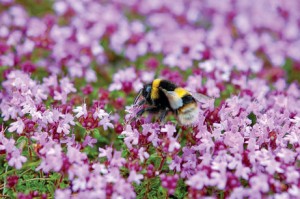
A debate has been raging between environmentalists and the Department of Agriculture over the possible connection between a common pesticide and the noted fall in bee population in recent years. Ireland recently abstained from voting for or against participation in a temporary EU-wide ban on the use of ‘Neonicotinoids’.
Fluctuations and overall reductions in the populations of bees have been observed globally in recent years and there are a number of possible explanations.
In some cases, local honeybee populations crash almost overnight for no apparent reason, in what’s known as Colony Collapse Disorder, which has dramatic effects on crop yields. Without a healthy bee population, pollination of plants decreases overall, effecting food production. In the event of Colony Collapse Disorder, even a person growing tomatoes on an allotment would notice the difference.
Experts are divided on the cause of these events, which are the most dramatic form of the trend of thinning bee populations. Apiarists (bee researchers) in the US have blamed the rise in mobile phone technology which they say affect bees’ ability to navigate. The use of the controversial Neonicotinoids since the 1990s, are a current sticking point as little research has been done on their possible long-term effects on the environment. A spokesperson for the Department of Agriculture recently conceded that no research had been conducted in Ireland on the relationship between Neonicotinoids and bee populations.
What can be done about this at a grassroots level? Where does the average gardener stand in relation to this overarching problem? NewsFour turned to our gardening expert Jim O’Doherty for an answer.
Jim first explained that research on the pesticide matter is more divided than it might be made to appear by people who support the temporary ban. “Germany, France and Italy have all banned Neonicotinoids already, unrelated to this temporary ban which is being discussed. It’s important that the proposed ban for the whole of the EU is temporary. It’s only a two-year moratorium while research is conducted into the effects of the chemicals, which says a lot to me.”
He speculated that since the Neonicotinoids are so commonly and frequently used, they are not likely to be the cause of the problem. “They are very commonly used, in garden sprays and in large-scale farming. At high concentrations, they might be a problem. I think the largest on-going threat to the honeybees is still parasites.”
Jim has his own theory on what is diminishing the bee populations at a local level and possibly all over the city. “Honeybees have hives and are maintained by a bee-keeper, but the other common type would be Bumblebees. Part of their lifecycle involves burrowing into compost heaps or into the topsoil and staying at rest, but if you look at somewhere like Ringsend Park for instance, now there’s a lot of artificial turf laid down there. It used to be all natural grass and white clover. The same goes for decking in gardens. People digging up the ground will dig up bees and when the decking goes down there’s less available ground for them to burrow.”
People need to facilitate creating better habitats for bees, by being more thoughtful about their needs. “And grow more wild flowers,” he adds, “Hollyhock, Cornflower, Foxgloves, Bluebells, the bees love them.”
By Ruairi Conneely

